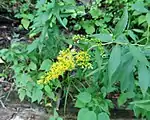Solidago gigantea
Solidago gigantea is a North American plant species in the sunflower family.[3]:211 Its common names include tall goldenrod[4] and giant goldenrod,[5] among others.
| Solidago gigantea | |
|---|---|
 | |
| Scientific classification | |
| Kingdom: | Plantae |
| Clade: | Tracheophytes |
| Clade: | Angiosperms |
| Clade: | Eudicots |
| Clade: | Asterids |
| Order: | Asterales |
| Family: | Asteraceae |
| Genus: | Solidago |
| Species: | S. gigantea |
| Binomial name | |
| Solidago gigantea | |
| Synonyms[2] | |
|
Synonymy
| |
Goldenrod is the state flower of Kentucky,[6] and Solidago gigantea is the state flower of Nebraska.[7]
Description
Solidago gigantea is a perennial herb that reaches heights of up to 2 m (6.6 ft) tall, sometimes spreading by means of underground rhizomes. It often grows in clumps with no leaves at the base but numerous leaves on the stem. At the top, each stem produces a sizable array of many small flower heads, sometimes several hundred. Each head is yellow, containing both disc florets and ray florets.[4]
 Detail of inflorescence
Detail of inflorescence
Habitat
Solidago gigantea is found in a wide variety of natural habitats, although it is restricted to areas with at least seasonally moist soils.[4][8]
Distribution
It is a widespread species known from most of non-arctic North America east of the Rocky Mountains. It has been reported from every state and province from Alberta to Nova Scotia to Florida to Texas, and also from the state of Nuevo León in northeastern Mexico.[9][10]
Environmental impact
Solidago gigantea is highly invasive throughout Europe and Asia.[11] In its non-native range, it exerts a negative impact on native communities by decreasing species richness and diversity, apparently due to its intense competitive effects,[12] rapid growth,[13] or polyploidization.[14] In the non-native European range, several management option are applied, such as periodical flooding, mowing, mulching, grazing, or herbicide to reduce the negative impact of the species on native biodiversity.[15]
References
- NatureServe (8 January 2021). "Solidago gigantea – Smooth Goldenrod". NatureServe Explorer (explorer.natureserve.org). Arlington, Virginia: NatureServe. Retrieved 6 February 2021.
- POWO (2019). "Solidago gigantea Aiton". Plants of the World Online (powo.science.kew.org). Kew, London: Royal Botanic Gardens, Kew. Retrieved 6 February 2021.
- Aiton, W. (1789). Hortus Kewensis; or, a catalogue of the plants cultivated in the Royal Botanic Garden at Kew (in Latin). 3. London: George Nicol. Retrieved 6 February 2021 – via Biodiversity Heritage Library.
- Semple, J.C.; Cook, R.E. (2006). "Solidago gigantea". In Flora of North America Editorial Committee (ed.). Flora of North America North of Mexico (FNA). 20. New York and Oxford. Retrieved 8 November 2014 – via eFloras.org, Missouri Botanical Garden, St. Louis, MO & Harvard University Herbaria, Cambridge, MA.
- "Solidago gigantea". Natural Resources Conservation Service PLANTS Database. USDA. Retrieved 18 November 2015.
-
Kentucky State Legislature. "Kentucky Revised Statutes: TITLE I SOVEREIGNTY AND JURISDICTION OF THE COMMONWEALTH - CHAPTER 2 CITIZENSHIP, EMBLEMS, HOLIDAYS, AND TIME - 2.090 State flower (PDF)". Kentucky General Assembly (legislature.ky.gov). Retrieved 6 February 2021.
2.090 State flower. The goldenrod is the official state flower of Kentucky. Effective: October 1, 1942. History: Recodified 1942 Ky. Acts ch. 208, sec. 1, effective October 1, 1942, from Ky. Stat. sec. 4618o.
- Nebraska Library Commission. "Nebraska State Symbols". NebraskAccess (nebraskaccess.nebraska.gov). Retrieved 6 February 2021.
- Hilty, John (2016). "Giant Goldenrod - Solidago gigantea". Illinois Wildflowers. Retrieved 15 July 2019.
- "Solidago gigantea". County-level distribution map from the North American Plant Atlas (NAPA). Biota of North America Program (BONAP). 2014. Retrieved 15 June 2015.
- "Photo of herbarium specimen collected in Nuevo León, Mexico". Tropicos (tropicos.org). Retrieved 15 June 2015.
- Weber, E.; Jakobs, G. (2 May 2005). "Biological flora of central Europe: Solidago gigantea Aiton". Flora - Morphology, Distribution, Functional Ecology of Plants. Amsterdam: Elsevier. 200 (2): 109–118. doi:10.1016/j.flora.2004.09.001. ISSN 0367-2530. Retrieved 14 May 2020.
- Pal, R.W.; Chen, S.; Nagy, D.U.; Callaway, R.M. (2015). "Impacts of Solidago gigantea on other species at home and away". Biological Invasions. New York: Springer. 17 (11): 3317–3325. doi:10.1007/s10530-015-0955-7. S2CID 3035546. Retrieved 14 May 2020.
- Jakobs, G.; Weber, E.; Edwards, P.J. (2004). "Introduced plants of the invasive Solidago gigantea (Asteraceae) are larger and grow denser than conspecifics in the native range". Diversity and Distributions. Diversity and Distribution. 10: 11–19. doi:10.1111/j.1472-4642.2004.00052.x. Retrieved 14 May 2020.
- Nagy, D.U.; Stranczinger, S.; Godi, A.; Weisz, A.; Rosche, C.; Suda, J.; Mariano, M.; Pal, R.W. (April 2018). "Does higher ploidy level increase the risk of invasion? A case study with two geo-cytotypes of Solidago gigantea Aiton (Asteraceae)". Journal of Plant Ecology. 11 (2): 317–327. doi:10.1093/jpe/rtx005. Retrieved 14 May 2020.
- Nagy, D.U.; Rauschert, E.S.J.; Henn, T.; Cianfaglione, K.; Stranczinger, S.; Pal, R.W. (June 2020). "The more we do, the less we gain? Balancing effort and efficacy in managing the Solidago gigantea invasion". Weed Research. Oxford, UK: John Wiley & Sons Ltd. 60 (3): 232–240. doi:10.1111/wre.12417. ISSN 1365-3180. Retrieved 14 May 2020.
External links
- Jepson Manual Treatment
- Solidago gigantea in the CalPhotos Photo Database, University of California, Berkeley
